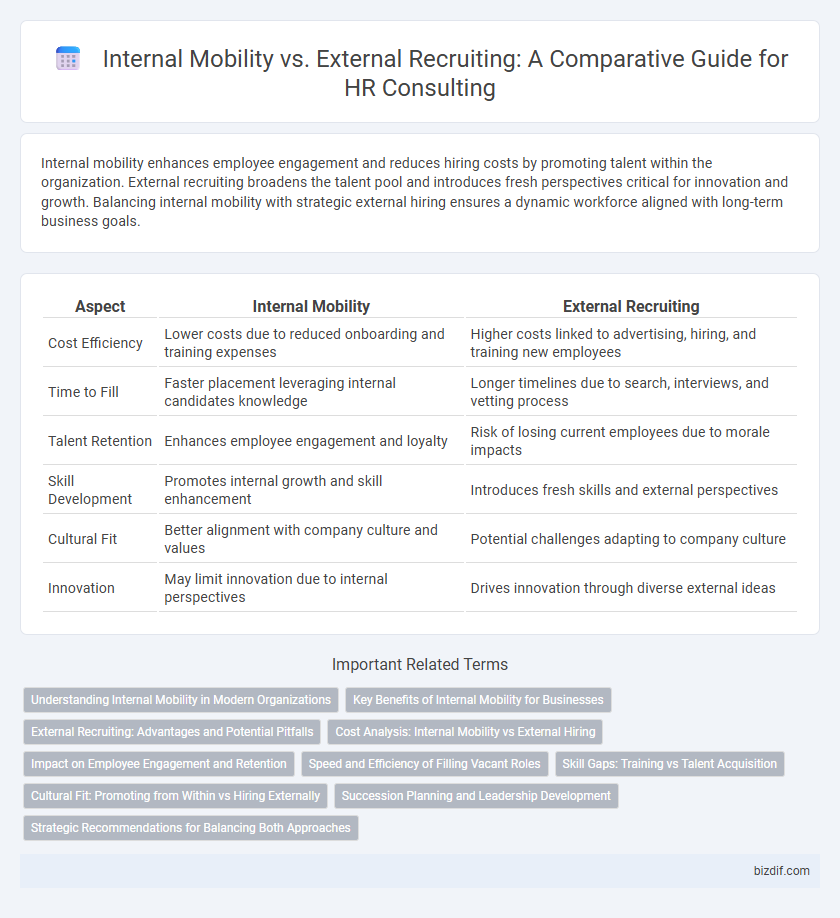Internal mobility enhances employee engagement and reduces hiring costs by promoting talent within the organization. External recruiting broadens the talent pool and introduces fresh perspectives critical for innovation and growth. Balancing internal mobility with strategic external hiring ensures a dynamic workforce aligned with long-term business goals.
Table of Comparison
| Aspect | Internal Mobility | External Recruiting |
|---|---|---|
| Cost Efficiency | Lower costs due to reduced onboarding and training expenses | Higher costs linked to advertising, hiring, and training new employees |
| Time to Fill | Faster placement leveraging internal candidates knowledge | Longer timelines due to search, interviews, and vetting process |
| Talent Retention | Enhances employee engagement and loyalty | Risk of losing current employees due to morale impacts |
| Skill Development | Promotes internal growth and skill enhancement | Introduces fresh skills and external perspectives |
| Cultural Fit | Better alignment with company culture and values | Potential challenges adapting to company culture |
| Innovation | May limit innovation due to internal perspectives | Drives innovation through diverse external ideas |
Understanding Internal Mobility in Modern Organizations
Internal mobility enhances employee retention by leveraging existing talent and reducing hiring costs, promoting organizational agility. It enables employees to develop new skills and advance careers within the company, aligning workforce capabilities with evolving business needs. Companies with strong internal mobility programs report 41% higher employee engagement and 20% lower turnover rates compared to those relying heavily on external recruiting.
Key Benefits of Internal Mobility for Businesses
Internal mobility boosts employee retention by leveraging existing talent, reducing recruitment costs by up to 50%, and shortening time-to-fill vacancies by an average of 30%. It enhances workforce agility by aligning employee skills with evolving business needs and fosters a culture of continuous development, resulting in increased employee engagement scores by 20%. Organizations with strong internal mobility programs also experience higher productivity levels and better succession planning outcomes, driving long-term business growth.
External Recruiting: Advantages and Potential Pitfalls
External recruiting offers access to a larger talent pool, enabling companies to acquire fresh perspectives and specialized skills that may not be available internally. This approach can accelerate organizational growth by filling skill gaps quickly and fostering innovation through diverse experiences. However, external hiring often involves higher costs, longer onboarding times, and risks related to cultural fit, which can affect employee retention and overall team cohesion.
Cost Analysis: Internal Mobility vs External Hiring
Internal mobility significantly reduces recruitment costs by minimizing expenses related to job postings, external agency fees, and onboarding processes. Promoting existing employees leverages their institutional knowledge, shortening training time and enhancing productivity. External hiring often incurs higher costs including relocation, salary negotiations above market rates, and a prolonged adjustment period impacting overall budget efficiency.
Impact on Employee Engagement and Retention
Internal mobility significantly boosts employee engagement by providing clear career progression and skill development opportunities within the organization, leading to higher retention rates. Companies that prioritize internal mobility report up to 30% greater employee retention compared to those relying heavily on external recruiting. Conversely, external recruiting can introduce fresh talent and ideas but often results in longer onboarding times and lower initial engagement, increasing turnover risk.
Speed and Efficiency of Filling Vacant Roles
Internal mobility accelerates the hiring process by leveraging existing employees who are already familiar with company culture and workflows, reducing onboarding time substantially. External recruiting often involves longer sourcing and vetting periods to identify candidates with the right skills and cultural fit. Companies prioritizing speed and efficiency in filling vacant roles benefit from internal mobility due to quicker role alignment and lower recruitment overhead.
Skill Gaps: Training vs Talent Acquisition
Internal mobility leverages existing employee skills and focuses on targeted training to close specific skill gaps, reducing onboarding time and fostering organizational loyalty. External recruiting fills immediate skill shortages by acquiring specialized talent unavailable internally but often requires longer integration and higher acquisition costs. Balancing internal training programs with strategic talent acquisition enables organizations to optimize workforce capabilities and maintain competitive agility.
Cultural Fit: Promoting from Within vs Hiring Externally
Promoting from within enhances cultural fit by leveraging employees already aligned with company values and internal norms, fostering stronger engagement and smoother transitions. External recruiting introduces fresh perspectives but poses risks of cultural misalignment and longer adaptation periods. Internal mobility supports talent retention and accelerates leadership development by rewarding demonstrated cultural compatibility and organizational knowledge.
Succession Planning and Leadership Development
Internal mobility enhances succession planning by leveraging existing talent familiar with company culture, accelerating leadership development through tailored career paths. External recruiting introduces fresh perspectives and broadens leadership potential pools, but often requires longer onboarding periods and cultural integration efforts. Combining both strategies optimizes leadership pipelines, balancing continuity with innovation to drive organizational growth.
Strategic Recommendations for Balancing Both Approaches
Strategic recommendations for balancing internal mobility and external recruiting emphasize leveraging internal talent pools to enhance employee engagement and reduce onboarding costs while selectively sourcing external candidates to inject fresh skills and diverse perspectives. Implementing a robust talent management system enables HR teams to identify high-potential employees for key roles, supporting succession planning and career development initiatives. Integrating data analytics into recruitment strategies ensures informed decision-making, aligning talent acquisition with organizational goals and market demands.
internal mobility vs external recruiting Infographic

 bizdif.com
bizdif.com